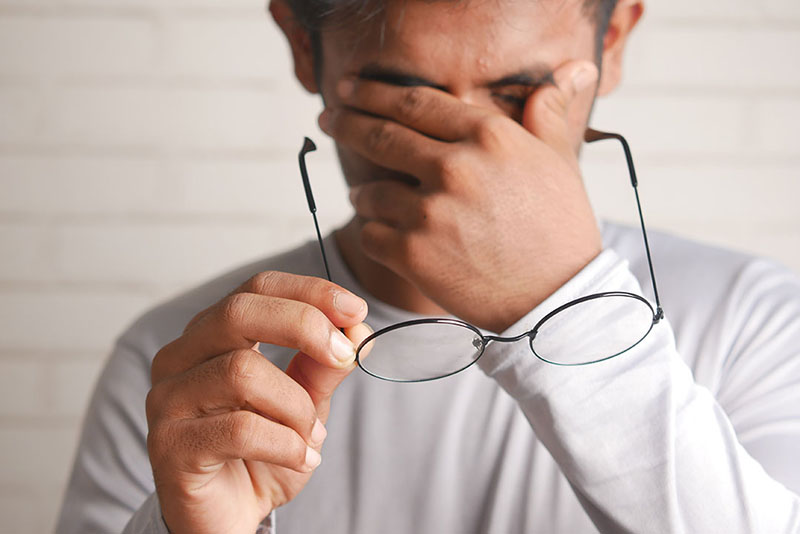
Are you looking for a pair of new optical frame glasses? While you might not know it takes a little time for you to adjust to your new glasses, why does it take time to adjust to new glasses? It’s necessary to know that there’s always gonna need a period for adjusting to new glasses, since the new frames and new lenses, your ears and eyes should not be used to it until a little time. How long does it take to adjust to new glasses? will you have symptoms like the following? Keep reading this article, and you will find the answer.

Does It Take Time to Adjust to New Glasses?
Yes, it does take a period to adust to new glasses for most people. Adjusting to new glasses typically requires time because both your brain and eyes need to acclimate to the alterations. This adjustment phase becomes necessary when there’s a change in prescription strength, astigmatism correction, frame size, or if you’ve been compensating for lower visual clarity. Such deviations from your accustomed vision might initially feel a bit unfamiliar.
Throughout this adaptation period, your brain and eyes collaborate to familiarize themselves with the new prescription, ultimately enhancing your visual clarity. If it’s your first time wearing glasses or if there’s a substantial alteration in your prescription, it might take your eyes longer (possibly a week or more) to adapt. Furthermore, trying progressive lenses for the first time might extend this adjustment period.
If you continue to experience discomfort even after 3 to 4 weeks with your new glasses, it’s advisable to contact your optometrist for further guidance. At Optics Town, we offer a 30-day return policy in case your glasses aren’t suitable for you.
How Long Does It Take to Adjust to New Eyeglasses?
It typically takes anywhere from a few days to two weeks to adjust to new glasses, although this can vary depending on the individual. The adjustment period is different for everyone, and factors such as the severity of the prescription change and the type of lenses used can influence the process. Gradual progression, starting with short wears and increasing the time spent wearing the glasses, can help the eyes and brain adjust to the new prescription.

Do You Have to Get Used to New Glasses?
Yes. Typically, it requires around two to three days for individuals to acclimate to a new prescription, although some may encounter eye strain and visual distortion for a period extending up to two weeks. This adjustment phase is a common occurrence since both your eyes and brain need time to familiarize themselves with processing visual information through a different lens. Whether it’s been a considerable duration since your prescription was updated or if this marks your initial experience with glasses, allowing your brain a day or two to acknowledge the clear, fresh visual input is crucial. Your brain has been compensating for impaired vision for an extended period, considering it as the “normal” state. However, it will gradually adapt to the new visual standard provided by your fresh eyewear.
Possible Problems of Getting Used to New Eyeglasses
Wearing new glasses for the first time can cause a few symptoms, such as:
- Blurred vision: Your eyes may struggle to focus on objects while adjusting to the new prescription.
- Headaches: Wearing new glasses can put additional strain on the eyes and cause headaches, especially during the initial adjustment period.
- Nausea: If the new glasses feel uncomfortable or cause blurred vision, it may lead to feelings of nausea or dizziness.
- Itching or redness: The eyes may feel itchy or red due to the increased pressure from the glasses or the material of the frames.
- Dryness: New glasses can create a slight pressure on the eyes, leading to a feeling of dryness or irritation.
Best Way to Adjust to New Glasses
There are indeed ways to decrease time of new glasses adjustment, Optics Town has concluded three ways for you:

Choose the Glasses that Suit you
- Visit an eye care professional: Schedule an appointment with an optometrist or ophthalmologist to determine your corrective lens prescription.
- Choose the right frame style: Consider the shape of your face, your personal style, and the level of comfort when selecting a frame. Try on different styles to find the one that feels the most comfortable and looks the best on you.
- Lens options: Decide on the type of lenses you need, such as single vision, progressive, or photochromic lenses. Consider any additional features, such as anti-reflective coating or blue light protection, based on your lifestyle and needs.
- Material and size: Select a frame material that suits your needs and is comfortable for you, such as metal, plastic, or wood. Ensure the frame is the right size and fits properly on your face.
- Break-in period: Be patient and allow yourself time to adjust to the new glasses. The adjustment period can vary, but it’s normal for it to take a few days to two weeks for your eyes and brain to adapt to the new prescription.
- Vision therapy: In some cases, vision therapy may be recommended to help speed up the adjustment process. Vision therapy involves exercises and activities designed to train your eyes and brain to work together more effectively.
- Consult your eye care professional: If you are experiencing significant discomfort or difficulty adjusting to your new glasses, consult your eye care professional. They may be able to provide additional guidance or recommend alternative options, such as a different frame style or lens type.
Gradually Increasing Glasses Wear Time
Adjusting to a new prescription for eyeglasses takes time, and it’s essential not to wear them continuously from the start. Instead, adopt a gradual approach, slowly increasing the duration of wear each day.
Begin with simple activities like watching TV while wearing your glasses. Once you feel at ease, progress to more visually demanding tasks, such as driving. Initially, limit the time you wear them to a few hours per day, gradually extending this duration until you can comfortably wear them throughout the day.
Consistent Glasses Use
For a smoother adjustment period, maintain a consistent routine of wearing your eyeglasses. Irregular use hinders your eyes’ ability to adapt to the new prescription. Aim to wear your glasses daily for at least an hour or more.
Avoid Using Old Glasses
Although your old frames might feel comfortable, wearing outdated prescriptions alongside new ones disrupts the adjustment process. This practice confuses your eyes and brain, potentially prolonging the time needed to adapt to the new lenses.
Reassessment of Prescription, if Necessary
Adapting to new glasses typically takes a few weeks, especially with minor prescription changes. If you’re still struggling beyond this period, it might signal a prescription error. Schedule an appointment with your eye doctor promptly for a thorough examination of the lenses to ensure they match your correct prescription.
Conclusion
Adjusting to new glasses is a common process that varies among individuals and depends on several factors such as prescription changes, lens types, and frame styles. It’s essential to understand that this adaptation period can take anywhere from a few days to a few weeks. During this time, it’s normal to experience symptoms like blurred vision, headaches, and discomfort, as your eyes and brain acclimate to the new visual input. Strategies like gradual wear, consistent usage, avoiding old glasses, and seeking professional guidance can facilitate a smoother adjustment. Remember, while some discomfort is expected, persistent issues beyond a few weeks may necessitate a reevaluation of your prescription by an eye care professional. Ultimately, patience and a systematic approach are key to successfully adapting to new eyeglasses. If you have more questions about eyeglasses, contact Optics Town, a professional optical eyeglasses wholesaler.




